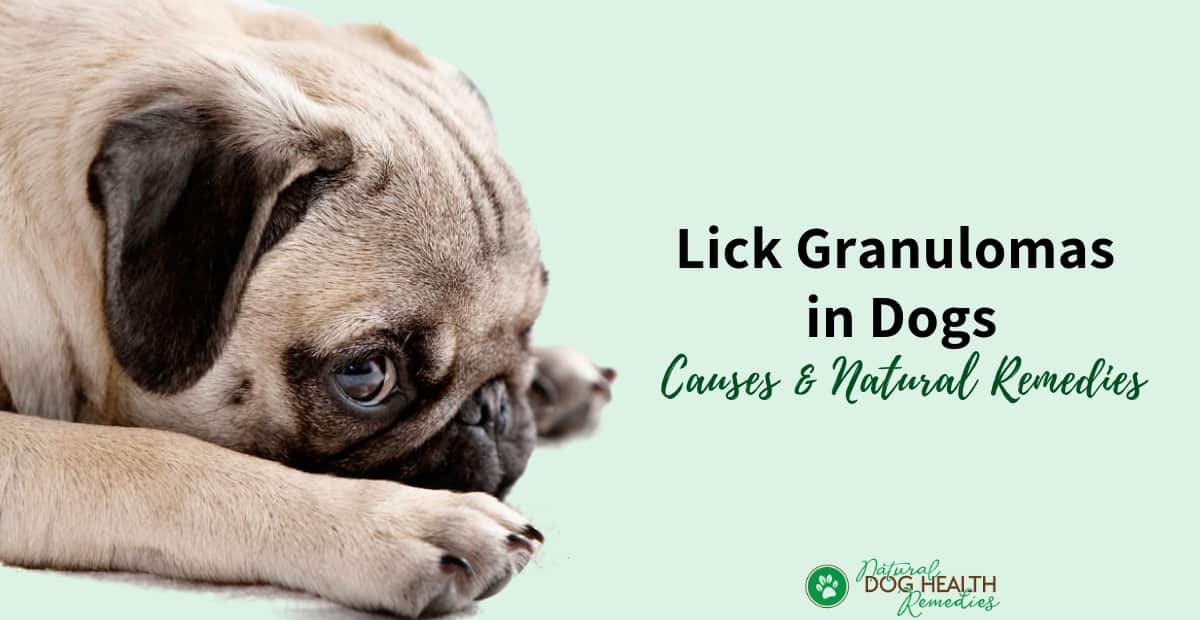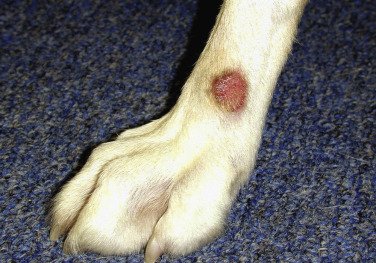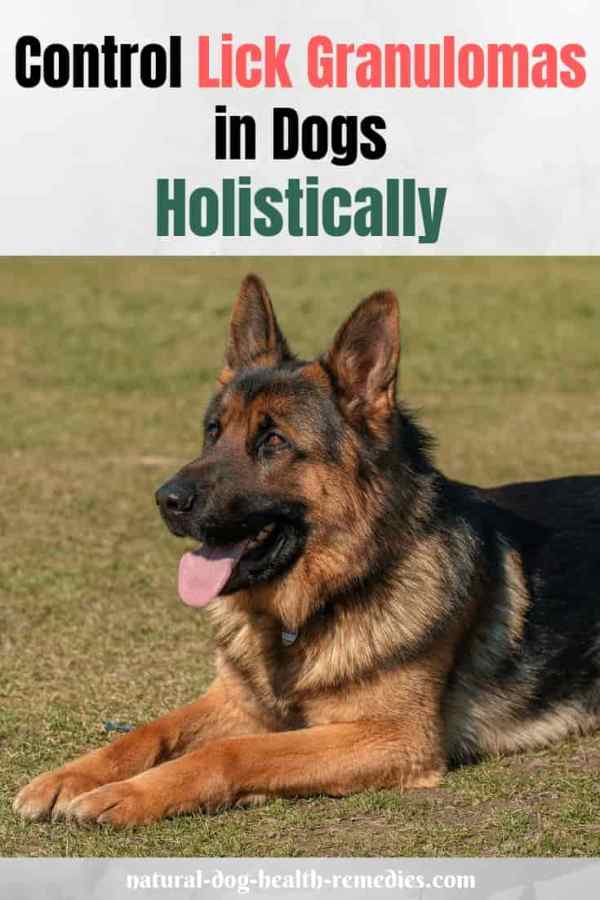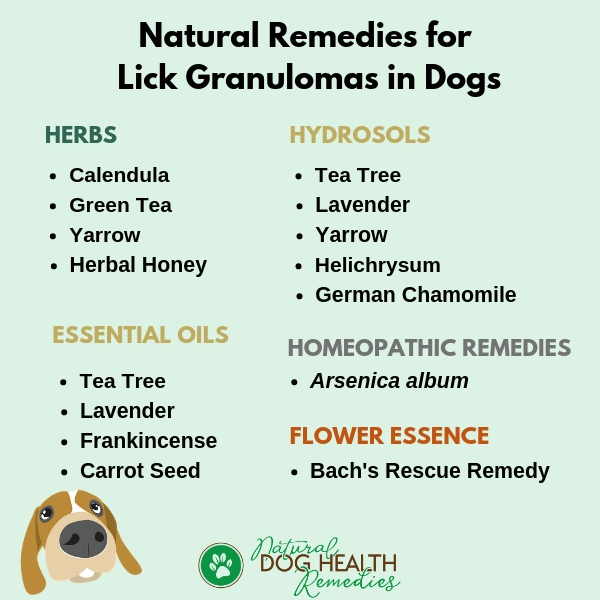Lick Granulomas (Acral Lick Dermatitis) in Dogs
(FTC Disclosure: If you make a purchase via a link on this page, I may receive a small commission, at no added cost to you.)

Overview
A lick granuloma results from a dog constantly licking a certain area of his body, usually the front part of the lower leg. Constant licking leads to hair loss and skin irritation.
As the problem worsens, the skin becomes red, raised, ulcerated and infected. Because of the constant licking, the ulceration and infection cannot heal easily.
Instead, the condition continues to worsen until the nerves become inflamed, causing the area to be so itchy that the dog licks it even more incessantly. Thus begins a vicious cycle and the condition becomes chronic.
Acral lick dermatitis can develop in any dogs, but some breeds tend to be predisposed. Usually, dogs affected are middle-aged, large breed dogs such as the Retrievers, German Shepherds, Boxers, among others.
Possible Causes of Lick Granulomas in Dogs
It is not clear as to what exactly causes this problem in dogs, although many veterinarians believe that a combination of medical and psychological factors are responsible, thus adding to the complexity of the problem.
One theory about the cause of lick granulomas is that, licking causes the release of endorphins in the dog's brain. Endorphins are brain chemical compounds that make us (and apparently dogs) feel good. The dog soon comes to associate licking with feeling good, so he keeps on licking.
Dogs may also lick themselves due to some other psychological/behavioral problems such as separation anxiety, boredom, and stress. These dogs relieve their stress by picking out new areas to focus on, then lick them for extended periods of time.
Physically, acral lick dermatitis can be triggered by the following:
- Allergies: Lick granulomas can occur as a result of allergies. Allergies bring about inflamed, itchy skin causing the dog to begin licking. In this case, appropriate treatment for the allergy usually resolves the problem.
- Arthritis and Pain: Lick granulomas can also be a result of pain due to an arthritic knee or ankle, sore muscles, or pain from trauma, or old wounds.
- Foreign Objects: A foreign object such as a splinter can get the dog focused on that particular spot. The dog will then start licking it in an attempt to remove the object and reduce the pain and discomfort.
- Fungal Infections: Deep seated fungal infections, such as ringworm, can initiate the licking problem as well.
- Cancer: Skin cancer can cause chronic lesions that are uncomfortable and can lead to chronic licking.
Symptoms of Canine Lick Granulomas

Photo Credit: Science Direct
The most obvious and consistent symptom is excessive licking of the front and rear legs.
In severe cases, lameness could occur due to infected skin, causing the dog to be lethargic.
Treatment for Lick Granulomas in Dogs
A wide array of conventional treatment is used to deal with this skin condition in dogs. Once diagnosed, the underlying problem that is causing the licking (e.g. allergies, arthrits, etc.) in the first place will be treated.
In addition, the secondary problems (licking and skin lesions) are tackled, most commonly by antibiotics, and/or anti-inflammatory medications.
Topical ointment such as steroid cream (to stop itching) or bad-tasting medications (to discourage licking) may also be prescribed.
In serious cases, cold laser therapy may be needed.
If the licking is a result of behavioral problems, behavioral modification medications and/or training will be given.
An Elizabeth collar may also be used to prevent the dog from licking.
Natural Home Remedies That May Help
 Once the underlying cause has been diagnosed, natural home remedies can be used to treat the root cause, and to stop the licking and heal the lesions.
Once the underlying cause has been diagnosed, natural home remedies can be used to treat the root cause, and to stop the licking and heal the lesions.
Herbal Remedies to Heal Skin Lesions
Herbs that have astringent, anti-bacterial, and wound-healing properties are ideal to heal skin lesions that are red, itchy, and inflammed. Some such herbs include:
CalendulaFor skin that is red and itchy, try using a calendula tea rinse. Calendula has anti-inflammatory, anti-bacterial, anti-viral, and anti-fungal properties and it is very effective in wound-healing.
To make a calendula rinse, steep a handful of calendula flowers in a cup of hot water and let the tea cool down. Use the tea as a rinse, apply it to the affected area, and let it drip dry. Repeat two to three times a day.
Green TeaA green tea poultice can be applied topically to badly inflamed areas after the dog is shampooed and the skin is dried off. Green tea contains tannic acid which can dry up moist areas caused by inflammation.
To make a green tea poultice, steep a couple of green tea bags in a cup of hot water and let the tea cool down. Use the tea as a poultice and apply it to the affected area. Repeat two to three times a day.
YarrowFor skin with open scratches, scabs, or oozing wounds, use equal parts of yarrow and calendula tea to make a rinse.
Yarrow is a very effective healing herb and when used in combination with calendula, the mixture will speed up the healing process and inhibit bacterial infection.
Herbal HoneyHerbal honey can easily be made and used to treat skin problems and infections such as lick granulomas. Honey is antibacterial and is excellent for wound healing.
An Ointment to Help Heal Skin Lesions
This ointment contains skin healing herbs (such as calendula, goldenseal, chamomile, comfrey, and more) and is helpful for skin infections, hot spots, and other skin irritations.
Essential Oils and Hydrosols
Tea Tree Oil
A study showed that using an ointment that contains 10% Tea Tree Oil resulted in a significant reduction in licking and disappearing of symptoms in 82% of the dogs being treated.
This is not surprising because Tea Tree Oil is highly antibacterial, antiviral and antifungal, and it has anti-itching properties as well.
Since Tea Tree Oil could cause adverse effects in some dogs, be sure to dilute the oil and do a patch test first. Observe your dog carefully to see if how he reacts. I would also add a skin nourishing oil (e.g. carrot seed oil or frankincense oil) and a calming oil (e.g. Lavender oil) to the blend.
For example, here is a recipe you may want to try:
- 4 drops of Tea Tree Oil (Melaleuca alternifolia)
- 4 drops of Frankincense Oil (Boswellia carteri)
- 2 drops of Lavender Oil (Lavandula angustifolia)
- 15 ml of Coconut Oil
Add the essential oils to the coconut oil. Mix well. Apply to affected areas 2-3 times a day.
To prevent your dog from licking the oil blend, lightly cover the areas with a bandage.
HydrosolsIf your dog reacts adversely to Tea Tree oil, try using hydrosols. They are milder and gentler for pets, and even smaller dogs and cats are fine with hydrosols.
Hydrosols good for itchy and inflamed skins include Lavender, Yarrow, German Chamomile, Helichrysum, and Tea Tree.
You can use any or a combination of these hydrosols as a compress or a spray.
Supplements for Healthy Dog Skin
In addition to topical remedies, supplements that support the skin can also be given to dogs with or prone to lick granulomas.
Omega-3 Fatty AcidsDogs with healthy non-itchy skin seldom develop lick granulomas. To ensure that your dog has strong health skin, a supplement of Omega-3 fatty acids is essential.
Fish oil such as
Only Natural Pet Pure Salmon Oil (Affiliate link) is rich in Omega-3 fatty acids.
Another important element for healthy dog skin is vitamins, especially vitamins A and E. These two vitamins are antioxidants. Vitamin A is essential for healthy hair and skin; vitamin E is anti-inflammatory and can prevent and improve chronic skin problems.
Other Remedies for Lick Granulomas
Homeopathy
The homeopathic remedy, Arsenica album (30c), helps alleviate itching and thus can reduce constant chewing and licking.
Flower Essences
If your dog have lick granulomas caused by behavioral problems such as anxiety or stress, try using
Bach Rescue Remedy Natural Stress Relief for Pets.
Add three drops to your dog's water bowl, three to four times daily, and you can see your dog gradually calm down and relax.
 References
References
Eldredge, et al. Dog Owner's Home Veterinary Handbook 4th edition (Wiley Publishing, 2007).
M.L. Wulff-Tilford and G.L. Tilford, Herbs for Pets (Bowtie Press, 1999).
D. Hamilton, Homeopathic Care for Cats and Dogs (North Atlantic Books, 1999).
Science Direct
Phytotherapy of chronic dermatitis and pruritus of dogs with a topical preparation containing tea tree oil (Bogaskin) - PubMed





